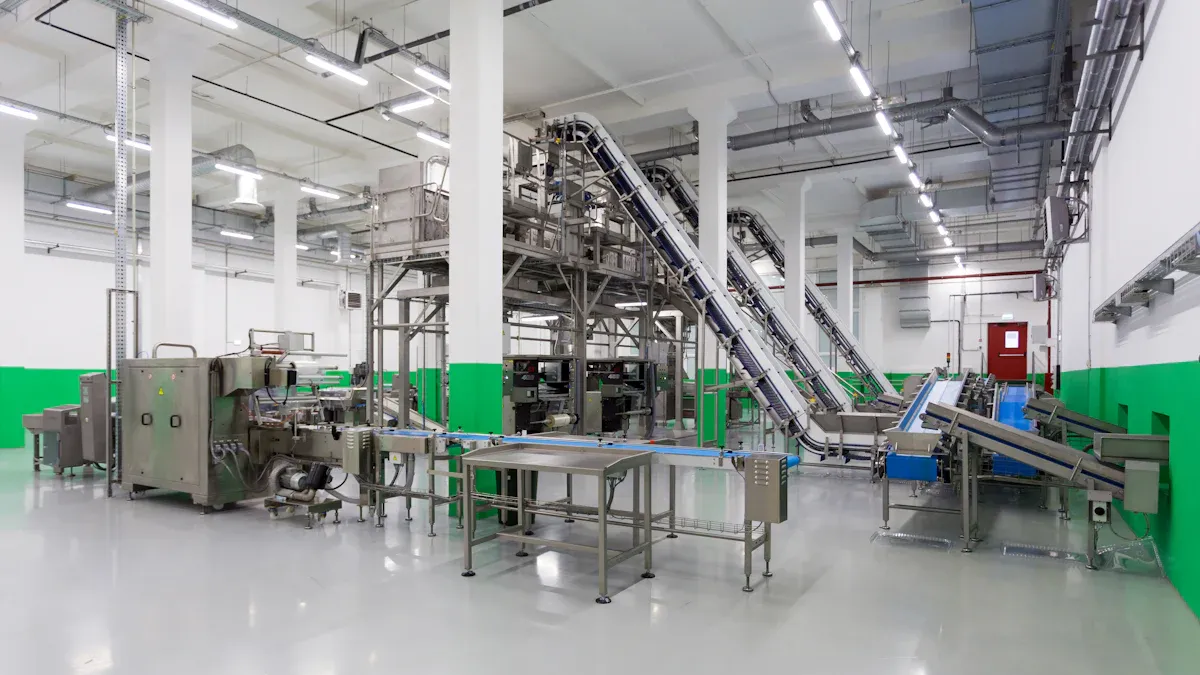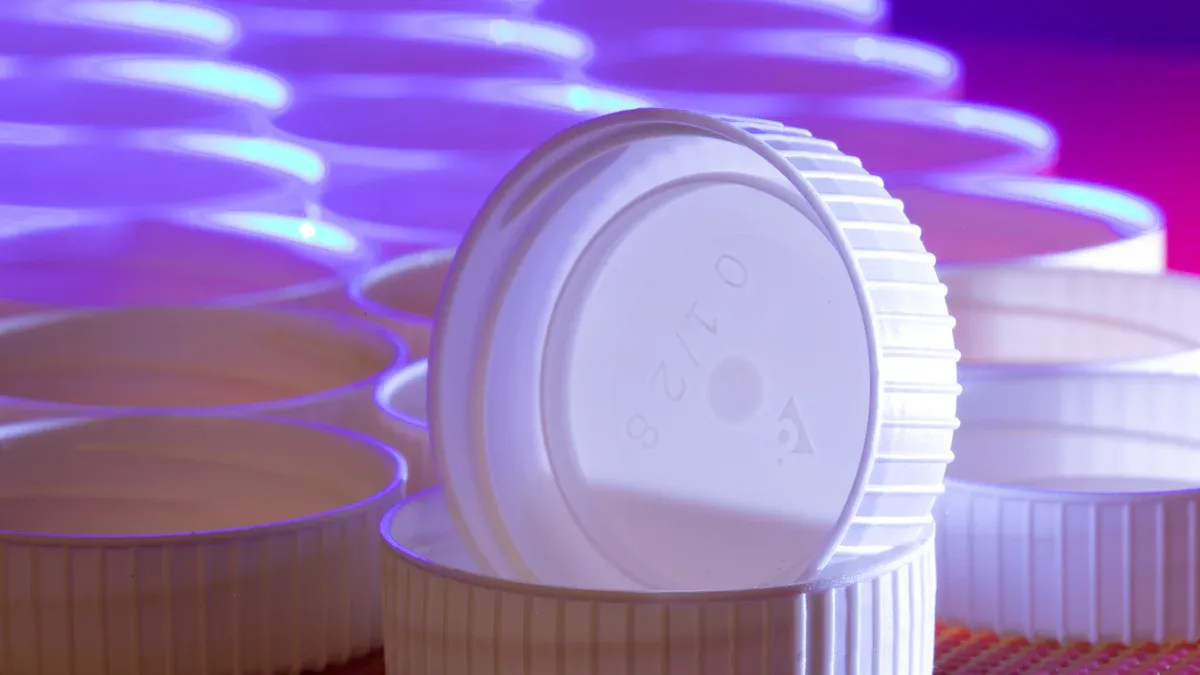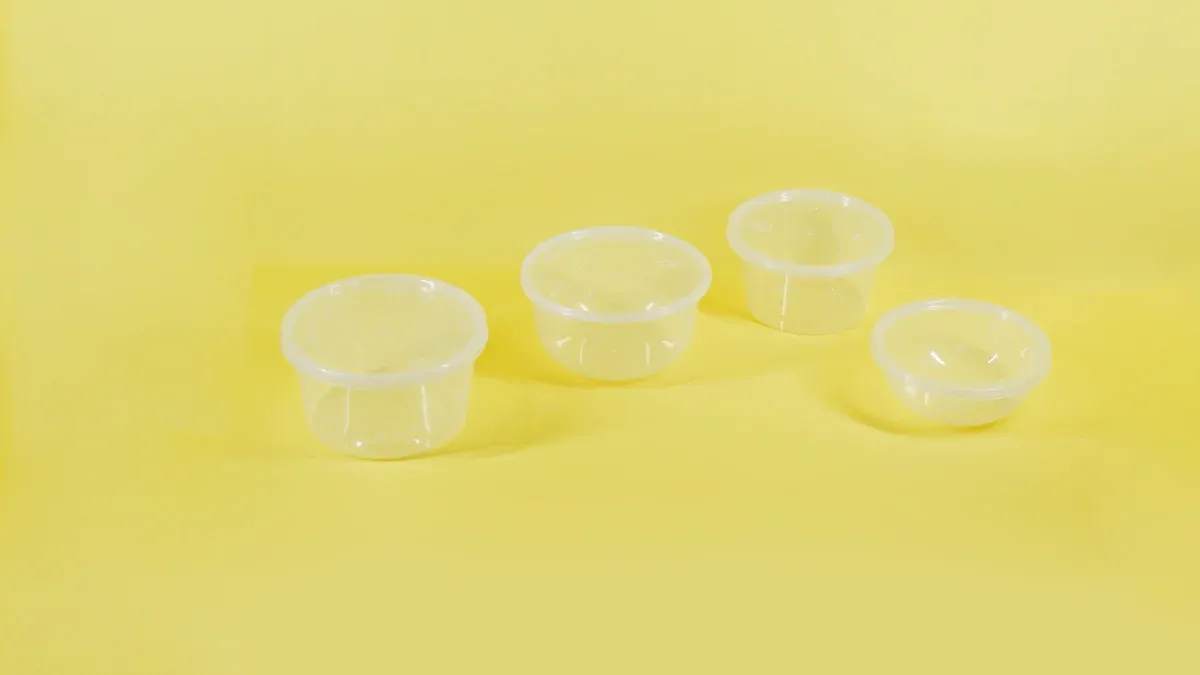
Ensuring the safety of food products starts with the materials that touch them. As a manufacturer, you play a key role in protecting consumers by adhering to food-grade compliance. This ensures the materials used in plastic lids remain safe for direct contact with food. Compliance not only safeguards health but also builds consumer trust. When your lids meet these standards, you minimize risks like contamination, chemical migration, or harm to users. By prioritizing compliance, you demonstrate your commitment to quality and safety in every product you produce.
Food-grade compliance refers to the strict adherence to safety standards that ensure materials used in food-contact products, like plastic lids, are safe for consumers. This means the materials must not transfer harmful substances to food or compromise its quality. In plastic lid manufacturing, compliance plays a critical role in protecting public health and maintaining trust in your products.
To meet these standards, manufacturers must use approved materials, such as non-toxic base polymers and controlled additives. These materials undergo rigorous testing to ensure they do not leach chemicals into food. For example, polyethylene terephthalate (PET) and polypropylene (PP) are commonly used because of their chemical stability and durability. By using such materials, you ensure that your lids meet the necessary safety requirements for food-safe plastic containers.
Compliance also ensures that your products align with global regulatory frameworks, such as FDA and EU standards. These regulations set strict guidelines for material safety, migration limits, and chemical stability. Following these rules not only protects consumers but also helps you avoid costly recalls or legal issues.
To achieve food-grade compliance, you must follow several key principles. These principles ensure that your plastic lids meet the highest safety standards and remain suitable for food contact.
These principles align with global standards, such as Regulation (EC) No 1935/2004, which requires that materials do not release harmful substances into food. By following these guidelines, you can produce food-safe plastic containers that meet both safety and quality expectations.
Food-grade compliance directly impacts the safety of your products and the reputation of your brand. When your plastic lids meet safety standards, you reduce the risk of chemical migration, contamination, or other hazards that could harm consumers. This not only protects public health but also builds trust in your brand.
High-quality packaging ensures that food remains fresh and safe throughout its shelf life. For instance, using materials like high-density polyethylene (HDPE) for milk jugs or polypropylene for microwave-safe containers demonstrates your commitment to safety and quality. These materials provide strong barriers against contamination and maintain the integrity of the food they protect.
Failing to comply with safety standards can lead to serious consequences, such as product recalls, legal actions, or damage to your brand's reputation. Advanced inspection systems and quality control processes help you maintain compliance and avoid these risks. By prioritizing food-grade compliance, you show your customers that you value their safety and trust.

Choosing the right materials for food-safe plastic lids is essential to meet food-grade plastic requirements. Commonly used materials include polyethylene terephthalate (PET), high-density polyethylene (HDPE), low-density polyethylene (LDPE), and polypropylene (PP). Each material offers unique benefits for food-safe plastic containers.
These materials undergo rigorous testing, such as migration and chemical resistance tests, to ensure they meet safety standards. Avoid using materials like PVC, which can release harmful chemicals into food.
When selecting materials for food-safe plastic containers, you must prioritize safety. Food-contact materials must comply with established safety standards to prevent health risks. Key considerations include:
| Key Consideration | Description |
|---|---|
| Compliance with Safety Standards | Materials must meet regulations like EC Regulation 1935/2004. |
| Assessment of Non-Intentionally Added Substances (NIAS) | Evaluating NIAS ensures no harmful substances are present. |
| Good Manufacturing Practice (GMP) | Proper manufacturing prevents harmful transfer of chemicals to food. |
| Intended Use Evaluation | Materials must suit the type of food and temperature conditions they face. |
By addressing these factors, you ensure your plastic lids remain safe and compliant throughout their lifecycle.
Additives play a significant role in maintaining food-grade compliance for plastic lids. However, not all additives are safe for food-contact materials. Harmful chemicals like bisphenols, phthalates, and perfluoroalkyl chemicals (PFCs) can pose serious health risks. For example:
To ensure compliance, you must carefully select additives that enhance the performance of plastic lids without compromising safety. Always verify that additives meet food-grade plastic requirements and do not release harmful substances into food.
The Food and Drug Administration (FDA) plays a critical role in ensuring the safety of food-contact materials in the United States. As a manufacturer, you must comply with FDA regulations to guarantee that your plastic lids and containers meet safety standards. These regulations protect consumers from harmful chemicals and ensure that food remains safe throughout its lifecycle.
The FDA enforces strict rules for food packaging. All materials, whether sourced domestically or internationally, must comply with these safety standards. This ensures that no harmful substances, such as microplastics or nanoplastics, migrate into food. The FDA also uses a positive list system. This system requires that every substance used in food packaging undergo evaluation and explicit approval. By following these guidelines, you enhance consumer protection and avoid regulatory actions that could prevent your products from entering the market.
Adhering to FDA regulations not only ensures compliance but also strengthens your brand's reputation. Consumers trust products that meet these high standards, knowing they are safe for use.
The European Union (EU) has its own set of regulations to ensure the safety of food-contact materials. The EU Framework Regulation (EC) No 1935/2004 serves as the foundation for food-grade compliance across member states. This regulation requires that materials used in food packaging do not release harmful substances into food.
To comply with EU standards, you must ensure that your plastic lids and containers meet specific safety requirements. These include migration limits, chemical stability, and suitability for intended use. The EU also mandates that manufacturers follow Good Manufacturing Practices (GMP) under Regulation (EC) No 2023/2006. GMP ensures that production processes minimize contamination risks and maintain the quality of food-contact materials.
By aligning with EU standards, you demonstrate your commitment to safety and quality. This not only helps you meet regulatory requirements but also builds trust with consumers across Europe.
In addition to FDA and EU standards, other global certifications play a vital role in ensuring food-grade compliance. These certifications help you meet the safety requirements of different markets and expand your reach.
Obtaining these certifications enhances your ability to compete in global markets. It also demonstrates your commitment to meeting the highest safety standards, regardless of where your products are sold.
By understanding and adhering to these global regulatory frameworks, you can ensure that your plastic lids and containers remain safe and compliant. This not only protects consumers but also strengthens your position in the industry.
Maintaining a clean and controlled environment is essential for ensuring compliance in plastic lid manufacturing. Good manufacturing practices (GMPs) emphasize cleanliness to prevent contamination and ensure food safety. You should focus on key areas such as personnel hygiene, plant sanitation, and equipment maintenance. For example, regular cleaning schedules and proper waste disposal reduce the risk of contamination during production.
Case studies highlight the importance of cleanroom infrastructure. For instance, XYZ Pharma reduced contamination events by 78% after upgrading their sinks and improving their facility design. This demonstrates how thoughtful planning and high-quality materials can enhance compliance and operational efficiency. By prioritizing cleanliness, you protect the integrity of your food-safe containers and meet regulatory standards.
Quality control and testing are the backbone of food-grade compliance. You must establish benchmarks to ensure that every plastic lid meets safety standards. Key benchmarks include FDA-approved raw materials, BPA-free certifications, and chemical resistance testing. Regular testing ensures that your products remain safe for food contact and comply with global regulations.
To streamline this process, implement checkpoints throughout production. For example, monitor injection molding temperatures and conduct leak tests to identify defects early. A robust testing system not only ensures compliance but also enhances the quality of your packaging. By investing in food-grade verification and testing, you build trust with consumers and avoid costly recalls.
| Category | Key Benchmarks |
|---|---|
| Material Safety and Compliance | FDA-approved raw materials, BPA-free certification, food-grade materials testing |
| Production Environment Standards | Clean room requirements, air quality monitoring, personnel hygiene protocols |
| Testing and Verification | Leak testing protocols, chemical resistance testing, food safety compliance |
Traceability and documentation are critical for maintaining compliance in plastic lid manufacturing. A robust traceability system allows you to track products from raw materials to finished containers. This ensures that every step of the production process meets safety standards. For example, batch coding systems and production records help you monitor product quality and identify issues quickly.
Documentation also plays a key role in regulatory compliance. By maintaining detailed records, you demonstrate adherence to food safety regulations and build buyer confidence. Efficient recall management is another benefit of traceability. If a safety issue arises, you can quickly identify and remove affected products, minimizing risks to consumers. A strong documentation system not only ensures compliance but also strengthens your brand's reputation.
| Aspect | Description |
|---|---|
| Significance of Traceability | Enhances food safety by tracking food products from farm to fork throughout the supply chain. |
| Compliance with Regulations | Traceability is a fundamental requirement for many food safety regulations, ensuring adherence. |
| Efficient Recall Management | Enables quick identification and removal of affected products during recalls, minimizing health risks. |
Chemical migration occurs when harmful substances transfer from plastic lids to food. This poses significant safety risks, especially for food stored over long periods or at high temperatures. You can mitigate these risks by selecting materials with proven chemical stability. For instance, polyethylene terephthalate (PET) and polypropylene (PP) are excellent choices due to their resistance to leaching. Regular testing of materials ensures they meet safety standards and remain safe for food contact.
Good manufacturing practices (GMP) also play a crucial role. By maintaining strict controls during production, you can prevent contamination that might lead to chemical migration. Testing for migration limits, as required by regulations like the FDA and EU standards, ensures your plastic containers remain compliant and safe for consumers.
Allergen management is critical in food-safe plastic containers. Even trace amounts of allergens can cause severe reactions in sensitive individuals. To address this, you must implement robust allergen control plans. These plans should include thorough cleaning protocols, dedicated production lines for allergen-free products, and regular testing to verify the absence of allergens.
Insights from the 2014 Global Food Safety Conference highlight best practices for allergen management. Industry leaders, including the FDA and Cargill, emphasized the importance of identifying allergens and preventing cross-contact. A white paper from the conference summarized key elements of effective allergen control plans, such as clear labeling and employee training. By adopting these practices, you can enhance safety and protect consumers with allergies.
| Key Element | Description |
|---|---|
| Conference | 2014 Global Food Safety Conference (GFSC) in Anaheim, CA |
| Focus | Allergen management as part of a safe food supply chain |
| Outcome | White paper summarizing industrywide survey results on allergen management practices |
| Expert Panel | Included members from Cargill, FDA, Costco, and other industry leaders |
| Purpose | Identify key elements of effective allergen control plans and promote best practices |
Contamination during production and storage can compromise the safety of food-safe plastic containers. To prevent this, you must maintain a clean and controlled environment. Regular sanitation of equipment and facilities reduces the risk of microbial contamination. Proper storage conditions, such as temperature and humidity control, also play a vital role in preserving the integrity of plastic lids.
Research on contamination prevention highlights the importance of sanitation interventions. For example, studies on pathogen survival and transfer in agricultural settings show how proper cleaning reduces contamination risks. By applying similar principles in your manufacturing process, you can ensure your containers remain safe for food contact.
| Study Focus | Findings |
|---|---|
| Pathogen Survival | Heat-treated poultry pellets extended E. coli survival in soil. |
| Sanitation Interventions | Organic amendments reduced contamination risks during growing cycles. |
| Microbial Transfer | Pathogen transfer dynamics depend on factors like drop height and age. |
| Cross-contamination | Postharvest water systems and surfaces can transfer foodborne pathogens. |
| Risk Assessment | Frameworks help understand pathogen transfer in preharvest conditions. |
By prioritizing cleanliness and proper storage, you can minimize contamination risks and ensure the safety of your plastic lids.

The future of food-grade plastic lid manufacturing is shifting toward sustainable food-grade solutions. Consumers are increasingly demanding eco-friendly packaging that aligns with their environmental values. Manufacturers are responding by exploring biodegradable plastics, recycled materials, and bio-based polymers. These materials reduce environmental impact while maintaining the safety and functionality required for food-contact applications.
The market for food-grade plastic lids is projected to grow significantly, reaching 46.51 billion USD by 2034. This growth reflects a compound annual growth rate (CAGR) of 3.4%. The rising demand for convenient and sustainable packaging solutions is driving this trend. By adopting sustainable practices, you can meet consumer expectations and contribute to a greener future.
Smart technologies are revolutionizing compliance monitoring in food-grade plastic lid manufacturing. Advanced sensors and IoT-enabled devices now allow real-time tracking of production parameters. These technologies ensure that every step of the manufacturing process adheres to safety standards. For example, smart systems can monitor temperature, humidity, and contamination risks, providing instant alerts if any parameter deviates from the norm.
Automation and artificial intelligence (AI) are also enhancing quality control. AI-powered systems can analyze data from production lines to identify defects or inconsistencies. This reduces human error and ensures that your products meet the highest safety standards. By integrating smart technologies, you can streamline compliance processes and improve the overall quality of your food-safe plastic containers.
Innovative testing methods are transforming quality assurance in food-grade plastic lid manufacturing. Techniques like liquid chromatography-tandem mass spectrometry (LC–MS/MS) and non-targeted analysis are now widely used to detect harmful substances. These methods provide precise results, ensuring that your products remain safe for food contact.
| Methodology | Findings | Challenges | Solutions |
|---|---|---|---|
| LC–MS/MS | Detected PFBS migration rates from 22%-75% | Background contamination from ubiquitous PFAS | High-quality solvents and extensive QA–QC procedures |
| Non-targeted analysis | Identified PFAS features but faced confirmation issues | Interferences mimicking PFAS transitions | High-resolution MS or additional sample cleanup required |
These advancements address challenges like chemical migration and contamination. By adopting cutting-edge testing methods, you can ensure compliance with global safety standards and enhance consumer trust.
Mastering food-grade compliance ensures the safety of your products and builds trust with consumers. By adhering to regulatory standards, you protect public health and strengthen your brand's reputation. Compliance also helps you avoid risks like contamination or recalls, ensuring your plastic lids remain safe for food contact.
Innovation and sustainability are shaping the future of food-safe packaging. Using eco-friendly materials and smart technologies, you can meet consumer demands while maintaining safety. These advancements not only improve your processes but also contribute to a healthier planet. Your commitment to compliance and innovation ensures your products stand out in the competitive food packaging industry.
Food-grade compliance ensures that plastic lids meet safety standards for food contact. These lids must not release harmful substances into food. Compliance protects consumers and builds trust in your products.
You can verify food safety by checking certifications like FDA approval or EU compliance. Look for materials tested for migration limits and chemical stability. Always source from trusted suppliers.
Tip: Request documentation from suppliers to confirm compliance with global standards.
Traceability helps you track materials and products throughout production. It ensures compliance with safety standards and allows quick recalls if issues arise. This protects consumers and your brand reputation.
Non-compliant materials may leach harmful chemicals into food, posing health risks. They can lead to recalls, legal penalties, and damage to your brand's reputation. Always prioritize compliance to avoid these risks.
Yes, many sustainable materials meet food-grade standards. Options like bio-based polymers and recycled plastics undergo rigorous testing to ensure safety. Choose certified materials to align with both safety and sustainability goals.
Note: Verify that sustainable materials comply with regulations like FDA or EU standards.